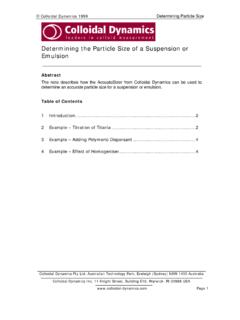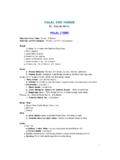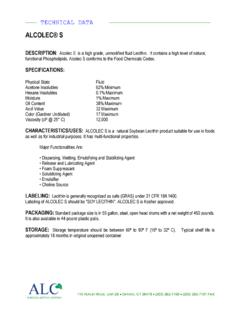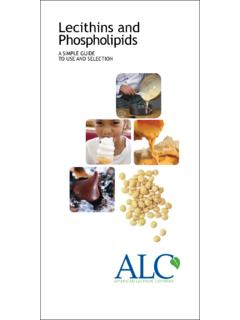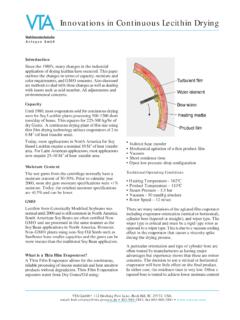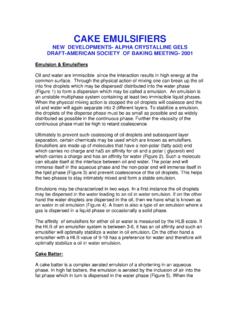Transcription of Preparing a Stable Aqueous Suspension from a …
1 Colloidal Dynamics Dispersing powders in water Preparing a Stable Aqueous Suspension from a Powder Abstract Aqueous colloids can be stabilised by pH control or by adding dispersants. In this article we set out the steps for making a Stable colloid and show how the ZetaProbe and AcoustoSizer can help in this process. Introduction To get a meaningful measurement of the size of the particles in a powder it is first necessary to produce a Stable dispersion in water. Preparing a Suspension from a fine powder usually requires the provision of a dispersing agent and/or the input of considerable energy, normally by stirring vigorously or sonication. The stirring process pulls the particles apart but they will only stay apart if they repel each other. This will be so if the particles have a big enough electric charge on their surface or if they become coated with dispersing agent.
2 For clay mineral particles one can often get sufficient dispersion by adjusting the pH to a high value (above pH 10) which gives the particles a high enough surface charge. This also works for most metal oxides, although some, like alumina, may be more dispersed at low pH (pH 4). Sodium hexametaphosphate, or sodium polyphosphate (Calgon) is a suitable dispersing agent for most inorganic materials. Sodium polyacrylate (PAA) (Dispex) is also a common dispersing agent. Both of these are solids readily dissolve in water and they are normally added at around 1% by weight of the solid. The other large class of dispersing agents consists of the detergents like sodium dodecyl sulfate (SDS) [often (wrongly) referred to as sodium lauryl sulfate]. Dispersing Agents The International Standards Organization has prepared a detailed report on the procedures required to properly disperse a sample prior to particle size analysis.
3 That report also contains suggestions for suitable dispersing agents for different systems. A sample of material from the report is provided in Tables 1 and 2. 1 Colloidal Dynamics Dispersing powders in water 2 Table 1 Sample Type Ionic Strength PH Suggested Dispersant or Dispersing Conditions Ionic Salt < Try common ion effect > Polyion Metal oxide < Adjust to pH<(pHiso 2) or > (pHiso + 2). > Polyion Clay minerals < Adjust to high pH (~ 10). See metal oxide. Protein As for metal oxide Non-polar organic < < 5 Quaternary amine salt < 5 - 8 Organic sulfonate < > 8 Organic acid salt > Phospholipid Low polar organic Polyionic (polyacrylate) Organic acid < Adjust pH (> pKa + 2) > Phospholipid Organic amine < Adjust pH (< pKb - 2)
4 > Phospholipid Fluorocarbon Per-fluoro organic acid Colloidal Dynamics Dispersing powders in water 3 Table 2 Category Dispersing Agent Commercial Examples (Manufacturer) Organic acid(or its alkali salt) Hystrene (Humkol) Pationic (RITA) Salt with triethanolamine AAS-60S(Vista), Stepanol WAT (Stepan) oleic acid sodium dodecanoate sodium linoleate sodium oxalate sodium tartrate PEO/fatty acid Alkasurf CO(Alkaril), 5430 (Emery) Organic amine (or amide or quaternary amine halide salt) Alkylamine Kemamine T (Humko), Armeen (Akzo) several (Pennwalt) PEO/long chain alkylamine Ethomeen (Akzo) Witcamide (Witco), E Series (Exxon) Trimethylalkylamine chloride (or bromide) Catramide PEO/methylalkylamine chloride (or bromide) Emcol CC (Witco) Ethoquad (Akzo) Ethanolamine, triethanolamine 2-amino-2-methyl propanol alkanolamide Atlas EM-16 (ICI), Monamine (Mona) Witcamide (Witco) PEO/alkanolamide Ethomid (Akzo) Imidazoline Alkaquat (Alkaril), Monateric LF-100 (Mona) Witcamine AL42-12 (Witco) Colloidal Dynamics Dispersing powders in water 4amino acid Lexamine (Inolex) Betaine Aerosol 30 (Cytec) Lexaine (Inolex) Monateric LMAB (Mona) Organic sulfonate sodium alkyl sulfonate Mersolate (R) H, Siponate (R)
5 SA (Alcolac), Ultrawet (R) (Arco) Emulgator (R) 30 sodium alkylnaphthalene sulfonate Dispersol (R) T, Perminal (R) BX, Tamol (R) SN, Alkanol (R) (Rohm & Haas) sodium alkylbenzene sulfonate Daxad (R) 23, Ultrawet (R) (Arco), AAS (R) (Vista) Isethionate Igepon (R) AC-78 (GAF) sodium dioctyl sulfosuccinate Aerosol (R) OT (Cytec), Emcol (R) 4000 (Witco) Taurate Igepon (R) T (GAF), Hostapon (R) T (Hoechst) Perfluoro organic acid Perfluoroctanoic acid Zonyl (R) (DuPont), Fluorad (R) (3M), Foralkyl (R) (Atochem) Phospholipid Lecithin Alcolec (R) (American lecithin), Lecithin (Troy) Polyester /polyacrylate Elvacite (R) (DuPont), Solsperse (R) (ICI) Polyionic salt sodium citrate = 2O sodium hexametaphosphate = Na6(PO3)6.
6 Calgon (R) sodium polyacrylate LW (R) 300, Dispex (R) 40 Maypon (R) (Stepan), SuperPro (R) Colloidal Dynamics Dispersing powders in water 5 sodium silicate sodium tetrapyrophosphate = sodium tripolyphosphate = (Stepan) (?Here or in next slot?) Note: Any alkali metal ion or ammonium may be used in place of sodium water-soluble organic Polyacrylate Darvan (R) C (Vanderbilt) Formaldehyde-naphthalene sulfonate Daxad (R) (Grace), Blancol (R) N (GAF), Tamol (R) N Micro (Rohm & Haas) Sulfonated lignin Polyfon (R) (Westvaco) Marasperse (R) (Reed Lignin) tannic acid Durtan (R) (Durkee) sorbitan laurate Sapan (R) 20 (ICI) tall oil acid salts Polyfac (R) MT (Westvaco) Finding a Suitable Dispersing Agent Go to Table 1 first and find the sample type which best fits your material.
7 Note also the concentration conditions represented by the ionic strength. If the salt concentration is low it is usually easier to promote dispersion. If it is high (above M) then you will probably have to use a polymeric dispersant. The first entry in Table 1 (common ion effect) refers to the possibility of dispersing say, silver bromide with either silver ions or bromide ions, which are special ions for that particular surface. That can be done for a few important sols but is not a common procedure. Consult Table 2 to find a suitable dispersant for your material in water. Proprietary names are given there to help with your selection. The Dispersion Process The powder should first be wetted with some water containing the dispersing agent. Mix it around a bit to make sure that the liquid is making contact with all of the solid.
8 Then it can be diluted to a suitable concentration. Colloidal Dynamics Dispersing powders in water 6 Normal samples can be mixed well with a high-speed stirrer, until they appear to be thoroughly homogeneous. Some hydrophobic organic materials may not respond well to this treatment, for high speed stirring may entrain large numbers of air bubbles to which the particles become attached. They will then float to the surface and be difficult to disperse. In this case you must avoid the production of a vortex in the mixing process by using a lower mixing speed. It is important to make sure that the material which has settled to the bottom of the container is properly mixed in with the rest. A highly dispersed sample of dense material can produce a sediment which is very difficult to redisperse simply by stirring, no matter how vigorously that is done.
9 It may well be necessary to dig the sediment out and wet it up from the paste before returning it to the remainder for the final stirring. An ultrasonic bath or an ultrasonic probe can help with the dispersion process and may be less destructive for some systems. Ultrasonication is a routine procedure for obtaining dispersion and for thoroughly redispersing a sample that may have been left standing in the lab for some time. However, you should be aware that it can produce chemical by-products which could affect your sample. It should not be used for long periods. A few minutes should normally be enough. After such treatment the sample should be ready for the AcoustoSizer or ZetaProbe. You can establish that the Suspension is Stable by checking that several successive measurements give the same reading for the zeta potential.
10 If it is not then you will need to stabilise the Suspension either by controlling pH or by adding dispersant. If you do not want to use artificial dispersing agents, like Dispex and Calgon or the detergents, then you should try and stabilise the Suspension by adjusting the pH. To do this, add some acid or base to adjust the pH while measuring the zeta potential in the datalogging mode, to see which direction the pH should be changed to increase the zeta potential magnitude. Continue to add acid or base to increase zeta until the reported zeta does not vary from one measurement to the next. At this stage the Suspension will look homogeneous, with no sign of the particle clouds that are evident in the unstable state. Once the Suspension is Stable , you can begin refining the dispersion procedure for this colloid by getting a clearer picture of how its zeta potential depends on pH.
